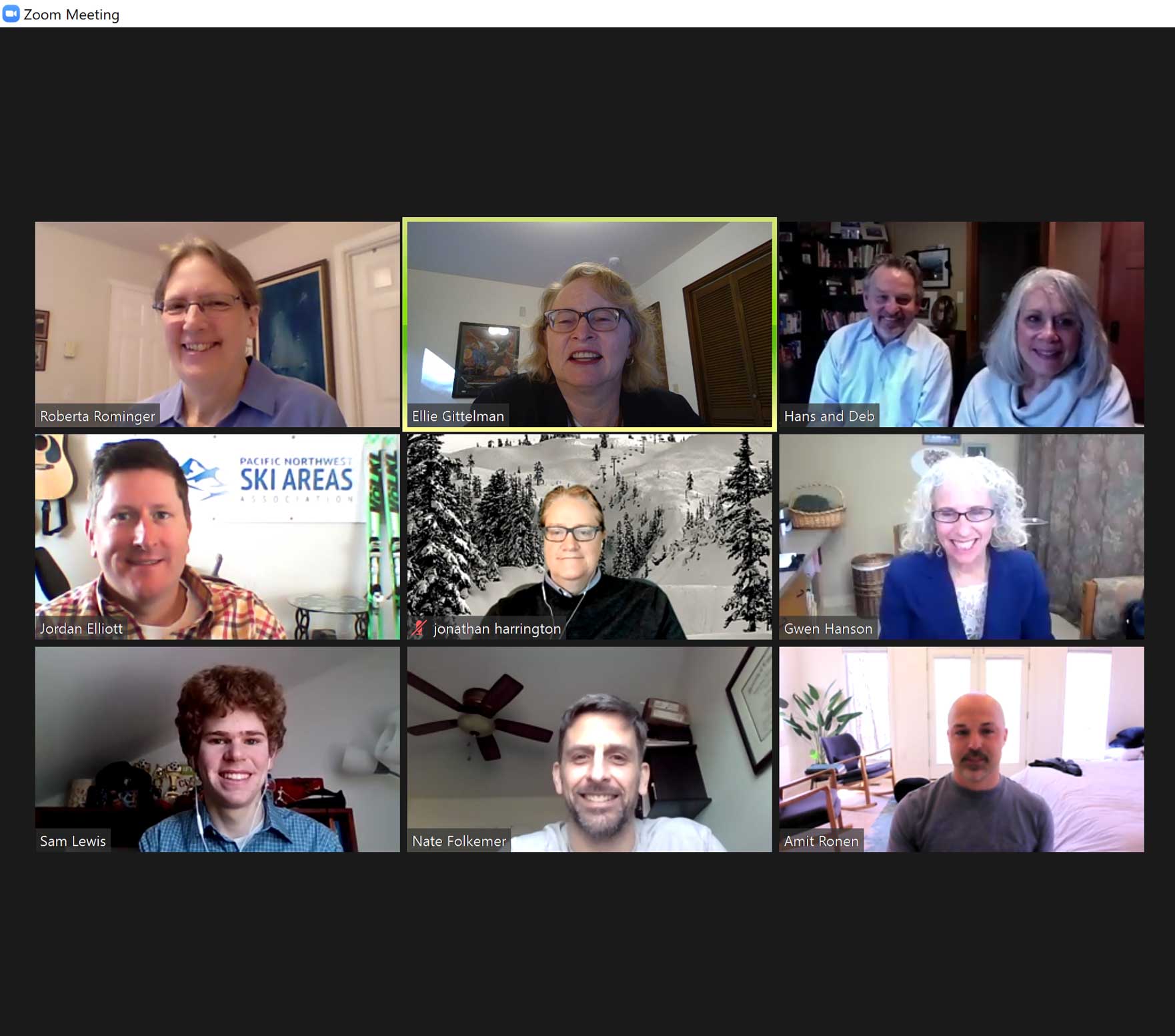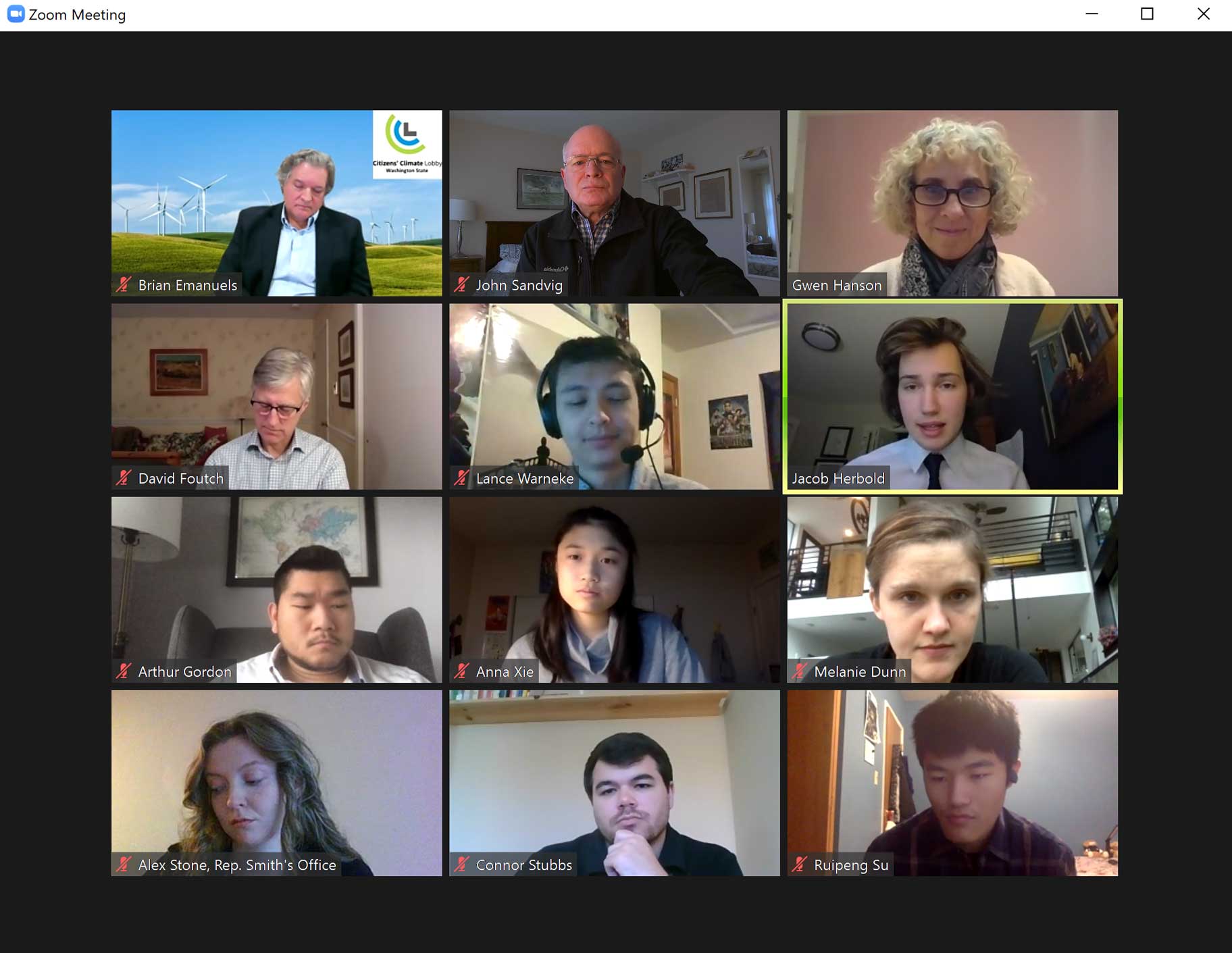Jake Herbold and Sam Lewis are part of the Citizens’ Climate Lobby (CCL) Youth Team: a nonpartisan, grassroots advocacy organization focused on national policies to address climate change. Jake, Sam, and their team of over 50 other youth members are currently lobbying for the Energy Innovation and Carbon Dividend Act (HR 2307). This bill places the burden of responsibility on polluters by imposing a tax on carbon emissions. The funds raised are then returned as monthly dividends (e.g., a ‘carbon cash back’) to American citizens. We sat down with Jake and Sam to learn more about why this bill has the potential to transform America’s climate landscape, as well as to serve as a model to inspire similar action in other countries around the world.
Both of you and the team have been lobbying for this bill since it was introduced in 2019. In simple terms, what is a carbon fee, and how does it work?
Sam: A carbon fee puts a fee on carbon at the fossil fuel source, somewhere like a mine or well. In our bill, the Energy Innovation and Carbon Dividend Act (Hr 2307), the fee will increase over time, starting at $15 per metric ton and increasing by $10 each year (or $15 if emissions targets are not met). By raising the price of carbon, making it more expensive to emit, the bill incentivizes renewable energy sources like nuclear and solar.

Your team has emphasized that this bill can reduce America’s carbon pollution by as much as 30% in the first five years alone, level the playing field for clean energy, and get America to net-zero by 2050. Talk me through how something as seemingly simple as a carbon price makes that possible.
Sam: Imagine you are writing an essay with pen and paper, and your professor tells you that you have to give him a dollar for every word you write. Pretty soon, you will invest in a computer and start typing your essays instead of writing them by hand. Carbon pricing works in a similar way. As the price companies pay to produce fossil fuels rises, the incentive to develop cheaper and cleaner energy sources does too. This induced innovation helps drive the development and implementation of new renewables like advanced nuclear plants that create high-paying jobs in the process. A great example of a successful carbon tax is Sweden’s carbon tax. This tax has been raised over its 30-year lifespan, lowering emissions while contributing to economic growth. Sweden’s carbon tax looks somewhat different from HR 2307, but the principle of how a carbon tax can reduce carbon pollution and simultaneously boost the economy stands.
One of the popular concerns around carbon taxes is that it could increase energy costs, and disproportionately affect low-income individuals or families who spend a larger percentage of their income on energy services. How is this addressed under HR 2307?
Sam: Not only do low-income individuals and families spend a more significant percentage of their income on energy services, but low-income communities also suffer the worst effects of climate change and environmental pollution. That’s why the Energy Innovation and Carbon Dividend Act is designed to protect low-income individuals by returning 100% of the net revenue from the carbon tax back to everyday people as a dividend. This direct check, similar to the current COVID stimulus checks, will arrive every month. At year 10, a family of four will receive about 3,000 dollars a year. This is projected to cover increased energy costs for 95% of the least wealthy 60% of Americans, and the lowest 10% of earners will experience an almost 10% gain from the dividend. HR 2307 is also projected to save just short of 100,000 lives a year from cleaner air and a more stable climate. Because low-income communities suffer the worst from pollution, they will see the most benefit from this policy. So, while many see carbon taxes as a regressive climate solution, the Energy Innovation and Carbon Dividend Act is designed to function more progressively.
In the U.S., climate issues have often been politicized along party lines, but HR 2307 has received bipartisan support from Democrats and Republicans alike. Why is that?
Sam: Our bill was explicitly written to be a bipartisan climate solution. When it was introduced in 2018, a third of the cosponsors were Republican. Unfortunately, of the 40 cosponsors on the reintroduced Energy Innovation and Carbon Dividend Act, none of them are Republican. This is attributed mainly to increasing political polarization at the federal level. Despite this, the bill has a lot of Republican support at the state and local levels, and, more generally, carbon pricing has 3 to 1 support among Republicans under 40. So, while combating the climate crisis has become a partisan issue on Capitol Hill, we think that through grassroots outreach and organizing, we can make HR 2307 a bi-partisan climate solution in Congress.
If HR 2307 was passed, how would it affect ordinary citizens?
Jake: Ordinary Americans would benefit greatly from this bill. Based on government data, our team calculated that a first-year carbon fee of $15 per metric ton of CO2 equivalent would:
- Raise gasoline by 16¢ per gallon.
- Raise natural gas by 9¢ per therm.
- Raise heating oil by 18¢ per gallon.
- Raise electricity by 0.6¢ to 1.4¢ per kilowatt-hour.
While this may seem like an overwhelming loss to Americans, the carbon dividend drastically offsets these cost increases. As reported by a study published by Greenspace Analytics, 61 percent of American families will either break even or come out ahead, and a 2017 Treasury Department study of a similar approach reported 70 percent of families would come out ahead. Thus, the overwhelming majority of Americans will be better off through the passage of this legislation.
Other than using the monthly stimulus checks to shield Americans from financial harm, the Energy Innovation and Carbon Dividend Act would also help create millions of new clean energy jobs. A study by Regional Economic Models, Inc, found that 2.1 million additional jobs would be made after ten years and 2.8 million after 20 years due to the Carbon Fee and Dividend policy.
Furthermore, new energy jobs created by the policy pay more, in comparative wages, than fossil fuel jobs.

Do you think HR 2307 could also be a model for how other countries could move towards a clean energy and net-zero future?
Jake: While it would be nice to think of HR 2307 as a new tactic in drawing down emissions, the worldwide consensus around carbon pricing was decided decades ago. As of January 2018, 42 national and 25 sub-national governments have instituted some form of carbon pricing. These include carbon taxes and emissions trading schemes (ETS) and cover about 22 percent of worldwide emissions. Of the 15 biggest economies globally, only three – the United States, India, and Russia – do not have any nationwide carbon pricing in place. This does not mean carbon pricing is a perfect solution by any means. Deeper legislation is needed to compel businesses and industry to change their environmental practices to a more sustainable model. But, passing HR 2307 would put the United States on a more climate friendly track, which is essential when trying to negotiate more radical policy with the rest of the world.
Climate change is such a large and complex crisis that it cannot be resolved by any single solution, such as a carbon fee. What other policy changes do you and the CCL Youth team believe need to accompany this bill in order to create holistic change?
Jake: Great Question! You are 100% right. The Energy Innovation and Carbon Dividend Act is not a silver bullet when dealing with the climate crisis. HR 2307 only covers emissions from the combustions of fossil fuels plus emissions of fluorinated gases. Other policies beyond HR 2307 will be needed to reduce non-fossil fuel emissions and to encourage carbon sequestering through biological and technological means.
Based on your experience, do you have any advice for people outside the U.S. who want to advocate for a carbon fee in their country?
Sam: CCL is an international organization with hundreds of chapters outside of the U.S. If there isn’t a CCL chapter near you, you can always get a few friends together and start your own. You can also browse Ecosia to find out if there are plans to introduce a carbon fee that you can advocate for or local organizations that are working on a carbon fee.
For more information about Citizens’ Climate Lobby, visit their website at citizensclimatelobby.org. Jake and Sam can be contacted at cclyouthoutreach@gmail.com, or on the CCL Youth Twitter, Instagram, and YouTube channel.
If you want to learn how you can support the Energy Innovation and Carbon Dividend Act (HR 2307), you can visit their website at energyinnovationact.org.
